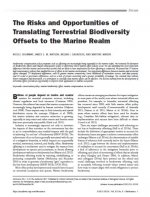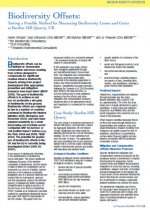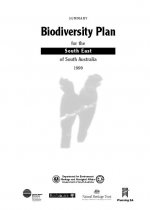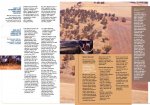The Risks and Opportunities of Translating Terrestrial Biodiversity Offsets to the Marine Realm
Nicole Shumway, James E. M. Watson, Megan I Saunders, Martine MaronBiodiversity compensation policy programs such as offsetting are increasingly being expanded to the marine realm. We reviewed the literature on biodiversity offsets and related compensatory policy to determine where marine offset policies occur. We also identified the most important differences between marine and terrestrial systems that are likely to have implications for how offsetting is […]
Compensatory mitigation as a solution to fisheries bycatch-biodiversity conservation conflicts
Chris Wilcox, C. Josh Donlan - The Ecological Society of America, The Ecological Society of AmericaGlobally, fisheries catch of non-target species has major environmental impacts, resulting in social conflict, litigation, and fisheries closures. We use a bio-economic approach to demonstrate that compensatory mitigation an innovative, market-influenced approach to fisheryconservation conflicts can facilitate high-value uses of biological resources and cost-effective conservation gains for species of concern. We illustrate the […]
The NSW Wetlands Management Policy
Government of AustraliaIt is the policy of the NSW Government to: encourage the management of the wetlands of the State so as to halt and where possible, reverse: loss of wetland vegetation; declining water quality; declining natural productivity; loss of biological diversity; and declining natural flood mitigation.
Implementing the Habitats Directive in Marine and Coastal Areas
European UnionThe Institute for European Environmental Policy (IEEP), London, is an independent institute concerned with advancing environmental policies in Europe. This seminar has been organised on the initiative of the Institute, in response to a perceived shortcoming in the application of the habitats Directive as it affects marine and coastal areas. We believe the event to […]
Multi-Agency Compensatory Mitigation Plan Checklist
United States Army Corps of EngineersThis document is intended as a technical guide for Clean Water Act (CWA) Section 404 permit applicants preparing compensatory mitigation plans. Compensatory mitigation is required to offset impacts that cannot be avoided and minimized to the extent practicable. The purpose of this document is to identify the types and extent of information that agency personnel […]
Biodiversity Offsets: Views, Experience, and the Business Case
Kerry ten Kate, Josh Bishop, Ricardo BayonBiodiversity1 offsets are conservation activities intended to compensate for the residual, unavoidable harm to biodiversity caused by development projects. Recent experience with regulatory regimes, such as wetland and conservation banking in the USA, tradable forest conservation obligations in Brazil and habitat compensation requirements in Australia, Canada and the EU, has been supplemented by growing interest […]
BBOP Glossary
2012 Update
BBOPA glossary of terms related to biodiversity offsets and the mitigation hierarchy, with particular reference to the BBOP approach and materials.
Biodiversity Offsets
Testing a Possible Method for Measuring Biodiversity Losses and Gains at Bardon Hill Quarry, UK
Helen Temple, Bob Edmonds, Bill Butcher, Jo Treweek - The Biodiversity Consultancy, SLR Consulting, Treweek Environmental Consultants, Treweek Environmental ConsultantsIntroduction Biodiversity offsets can be defined as measurable conservation outcomes resulting from actions designed to compensate for significant residual adverse biodiversity impacts arising from project development after appropriate prevention and mitigation measures have been taken (BBOP 2009). The goal of biodiversity offsets is to achieve no net loss (or preferably a net gain) of biodiversity […]
Summary: Biodiversity Plan for the South East of South Australia, 1999
Tim Croft, Tatia Zubrinich, Ann Shaw Rungie, Alison Oppermann, Georgina HouseThe conservation of our natural biodiversity is essential for the functioning of natural systems. Aside from the intrinsic importance of conserving the diversity of species many of South Australia’s economic activities are based on the sustainable use, conservation and management of biodiversity. Biodiversity Plans are able to provide a focus for the conservation and management […]
Victoria ‘s Native Vegetation Management: A Framework for Action Summary Brochure 3
Government of AustraliaWhile the Framework sets a new standard for future management, significant work has occurred over the last 10 years. Our farmers and land managers have been at the forefront of Victorias native vegetation management efforts. Through the Landcare, Land for Wildlife, Bushcare and salinity programs as well as individual efforts, the rural community has strongly […]











